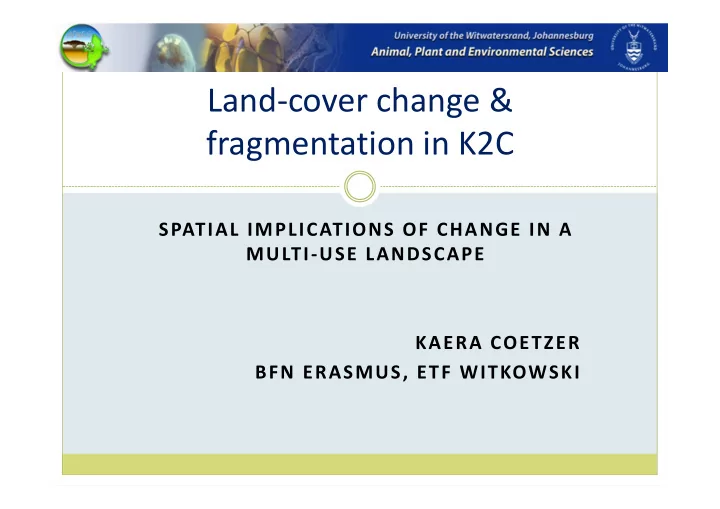

Land-cover change & fragmentation in K2C SPATIAL IMPLICATIONS OF CHANGE IN A MULTI-USE LANDSCAPE KAERA COETZER BFN ERASMUS, ETF WITKOWSKI
Biosphere Reserves & Conservation Planning � Biosphere reserves (BR) vs. traditional protected areas (PAs) � Multi-use landscape � Potential for spatial conflict � Zonation of BRs � Core, Buffer, Transition zones � Conservation planning : ecosystem & regional planning � K2C : established 2001 � 3 rd largest internationally, largest in SA
K2C: Study Region
LAND-COVER MAPPING: Available Data 1993 -2006 � LAND-COVER CHANGE component : understanding ‘threats’ to biodiversity � 8 winter LandSat image pairs � 12 broad classification classes, NLC naming conventions Today's presentation : � Years: 1993, 2006 : Net change � Priority Cover Classes: Settlement, Human Impacted Vegetation, Intact Natural Vegetation � Intact : priority biodiversity conservation class of untransformed habitat � Settlement & Impacted Vegetation : land-cover in varying states of human utilization and modification � Landscape Metrics
1993, 2006: Status quo land-cover maps 1993 2006 Coetzer et al. 2010. SAJS:106 (7/8)
Zoom-in on Intact Vegetation : NW K2C 1993 2006 Coetzer et al. 2010. SAJS:106 (7/8)
1993, 2006: Status quo land-cover maps 1993 2006 Coetzer et al. 2010. SAJS:106 (7/8)
K2C Land-cover : Zoom-in on Bushbuckridge 1993 2006 Coetzer et al. 2010. SAJS:106 (7/8)
Persistence Map : 1993 - 2006 ∆ : 36% of K2C Coetzer et al. 2010. SAJS:106 (7/8)
% Area Changes in classes: 1993, 2006
Priority Classes: Net Contributors to change 400 300 Priority Classes: 200 100 Comb. Intact Vegetation: Woodland, Thicket & Bushland 0 Area (km 2 ) Impacted Vegetation -100 Settlement -200 -300 -400 Exposed Intact Settlement Impacted Cultivated Grassland: Ground Vegetation Vegetation Lands Natural & Managed Land-cover classes
Gains, Losses, Persistence : ‘GLP Maps’ Year X Year X + t Losses Persistence Gains Net change = Persistence area + Gain areas – Loss areas
LANDSCAPE METRICS: analysis of the pattern of change � Average Patch Size, Number of patches � Indicates fragmentation, transformation Focal cover Matrix cover � Shape Index � irregularity of patches. Edge: interior ‘habitat quality issues’ Increasing shape index Edges: n = 12 Edges: n = 18
LANDSCAPE METRICS: analysis of the pattern of change � Aggregation index, Interspersion & Juxtaposition � aggregation of patches, intermixing with surrounding land- cover Decreasing aggregation, Increasing interspersion Matrix cover-types � Cohesion Focal cover � structural connectivity across landscape Landscape Increasing cohesion extent
SETTLEMENT (1993 – 2006): Spatial distribution of Gains, Losses, Persistence Excluded Classes Losses Persistence Gains Photo credit: BFN Erasmus; Xanthia Village, Bushbuckridge Source: Coetzer et al. (Submitted 2011)
IMPACTED VEGETATION (1993 – 2006): Spatial distribution of Gains, Losses, Persistence Excluded Classes Losses Persistence Gains Source: Coetzer et al. (Submitted 2011) Photo credit: BFN Erasmus; Bushbuckridge
INTACT VEGETATION (1993 – 2006): Spatial distribution of Gains, Losses, Persistence Excluded Classes Losses Persistence Gains Source: Coetzer et al. (Submitted 2011) Photo credit: BFN Erasmus; Xanthia
SO WHAT? Big-Picture issues for K2C � Land-cover change not limited to transition zone � Space limiting factor � Worsened by socio-economic circumstances � Future development priorities for Poverty nodes � Transformation up to PA fences � Long-term consequences for K2C’s ‘Biosphere’ status: � Catch 22: Human needs versus Environmental protection � Re-examine zonation : Buffer Zones � International BR failures, successes : compare to K2C � RETHINK required?
Acknowledgements � Andrew W. Mellon Foundation � National Research Foundation (NRF2069152) � The University of the Witwatersrand
Recommend
More recommend